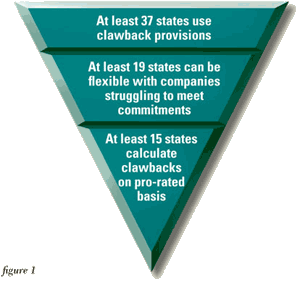lawback – the word invokes images of scary, bony fingers from a horror movie scene. Is the image a fair one? Can – and do – the bony fingers of clawback provisions reach into the pockets and wallets of companies and take back investment incentive monies? Are clawback provisions … safe?

What is a Clawback?
Economic development organizations frequently offer incentives to attract companies. In many cases, the company and the EDO enter into a contractual agreement before the project begins. The EDO commits to deliver incentives, and the company commits to create a certain number of jobs, make a given investment, and/or maintain its area operations for a minimum period of time. If the company fails to meet its commitment, the presence of a clawback provision in the agreement could require the company to pay back some or all of the money it received.
In a recent survey, Grubb & Ellis Consulting spoke directly with 31 states, 25 of which reported using clawback provisions. Additional research yields at least 12 more. We found the use of clawbacks dating back to the 1980s.
Fifteen of the states we interviewed specifically cited the ability to claw back on a pro-rated basis. That is, if a company promised to create 100 jobs and only created 75, it would only be required to repay 25 percent of the incentive.
We found a lot of discussion among the state EDOs about performance-based programs, in which a company does not receive any money until after it has fulfilled its obligations, thus eliminating the need for clawback provisions. One modification of this approach allows companies to claim credits, loans, etc. in phases. If at any point the company’s performance falls below the agreed upon levels, the incentive simply stops.
Forgiveable loans are another type of performance-based incentive. If a company meets its targets, the loan is converted to a grant. If it doesn’t, it must pay back the loan (typically at a favorable interest rate, which means it is still a pretty good deal).
In the case of training incentives and infrastructure assistance, we found that states worry less about clawback provisions, arguing that, even if a company leaves, the training and/or infrastructure are investments that remain with the community.
In states where grant programs allow for up-front cash awards, clawback provisions are almost always a part of the incentives agreement.
We found at least three states that award state grant monies through the local economic development organization. In these cases, clawback responsibility rests with these local EDOs.
Experience, research, and a handful of interviews with local EDOs tell us that the use of clawback provisions varies widely at the municipal and county level.
In a word, yes. Clawbacks are enforced, and increasingly so. While there are few reports of clawbacks being enforced during the 1990s, states are becoming more rigorous in their efforts to track performance and pursue repayment in cases where companies fall short. Here are just a few examples:
• In August 2007, USA Today reported that, following an audit of its incentive programs, the State of New York sent letters to 3,000 companies that were found to have met less than 60 percent of what they promised. By January 2008 the Times Union reported 180 companies deemed not to have made progress toward their goals had been sent certified letters giving 10 days to explain shortfalls or face loss of Empire Zone certification.
• In an article dated June 16, 2007, The Wall Street Journal reported that the State of Virginia “has collected about $11 million in repayments” since stepping up its audit program in 2002. The same article referenced new clawback provisions that had been put in place – and used – in New Jersey.
• A report from the Office of the Governor in Texas on its Texas Enterprise Fund program indicates a total of approximately $300,000 has been recaptured from three companies since 2004.
• Illinois’ Annual Report of Recaptures Provision (6/1/07) shows 24 efforts have been initiated since 2004 to reclaim incentives; 16 have been completed.
Local community enforcement is harder to track. It stands to reason that the host community has the most to lose should a company not meet its obligations. It bears the direct impact of jobs not created or scaled back shortly after creation. It is, therefore, no surprise that some of the most aggressive efforts to recapture incentives occur at the local level. In her article “Negotiating the Ideal Deal,” Rachel Weber, Assistant Professor for Urban Planning and Policy Program at the University of Illinois at Chicago, noted a 2003 payback of $13.1 million by Philips Semiconductor to the City of Albuquerque when it closed its plant there. The Wall Street Journal article mentioned above cited $4 million reclaimed by Minnesota communities since 2002.
Despite the number of clawbacks that are occurring (see figure 1), there are differences between locations with regard to their propensity to enforce their clawback provisions. At one end of the spectrum are organizations focused on protecting taxpayers against gross misuse of incentives. These EDOs tend to be more flexible when working with companies that put forth their best efforts and can prove that extenuating circumstances rather than lack of commitment have caused the shortcoming. Our survey found 19 states that had some room to maneuver, be it through extending deadlines, developing work-out plans, or amending the incentives agreement.

In some cases, flexibility was fairly limited; in others, it was fairly liberal.
At the other end of the spectrum are those EDOs that take a hard-line approach. If a company can’t keep its end of the bargain for whatever reason, then, in the interest of the taxpayers they represent, they will require the company to pay the money back. Many will charge interest; some will assess penalties. No hard feelings, no angry words, it’s just business.
It’s actually a bit hard to argue with the logic. No one expects a bank lender to forgive a debt of a borrower who finds him/herself unable to pay! Nevertheless, clawback provisions in this type of atmosphere can limit a company’s flexibility to respond to changing conditions. Five states indicated that they were required to enforce the clawback provisions as written with no room to renegotiate.
Companies desiring a better understanding of where a location falls on the spectrum can learn more through a review of the incentive program’s enabling legislation, discussions with state representatives, and a review of the program’s history.
More and more states have established standard documentation for incentive agreements. The language of the clawback provision is either set by statute or by program guidelines and cannot be changed on a case-by-case basis. Very few states seem to have complete flexibility in framing the clawback.
Many states interviewed reported a lowering of the company’s targets during the negotiation period, as in, “Did I say 200 new jobs? I meant 175.” Many state EDOs report strongly encouraging companies to scale back their projections to a comfortable level.
Even when a company is presented with seemingly inflexible documents, it may have some room to negotiate related points, such as whether job creation at a nearby sister company can be counted toward the total job count.
In the course of negotiating one unusual case, Grubb & Ellis Consulting worked on an incentives agreement between a state and the distribution function of a Fortune 500 company that planned to use a third party logistics company to operate its facility. While our client was clearly responsible for the creation of the jobs, the employees would be working for a different (and as-yet unnamed) entity. This raised questions as to which company would be responsible for maintaining target employment and wage levels. Our solution involved creative language in the incentives agreement. The state EDO accepted the language and created a win-win situation for the state and the client, recognizing the long-term nature of the client commitment despite the short-term 3PL agreement.
Local EDOs (those representing cities, counties, etc.) are likely to have more leeway in how they draw up the incentives agreement. A past incentive negotiation project involved a local incentives clawback tied to a lease agreement. At the request of our client, we negotiated an incentives agreement allowing continuation of the incentives should the space be occupied by an affiliate of the company as long as business activity in the space was continued at the same level.
If a company is overstating its investment and job creation potential in order to obtain larger incentives, it should approach a clawback provision with great care. We strongly advise against this form of negotiating. The company may get a larger incentive award in the short term, but it will pay for it down the road – both monetarily and with its reputation.
A company committed to realistic goals should have only moderate concern. Chances are good that the company will make its targets, but market conditions do sometimes shift suddenly and without warning. At the extreme, consider the impact that the 9/11 tragedies had on the airline industry. But mergers, acquisitions, recessions, product obsolescence, the loss of a key customer and any host of everyday occurrences can also alter the best laid plans.
Does that mean companies should never sign a clawback agreement? Absolutely not! Incentive packages can offset major project costs, and make an otherwise impossible project doable. If signing a clawback provision is what it takes to qualify for the incentives, the return can outweigh the risk. In deciding, a company must carefully weigh and understand its exposure should the project not go as planned.
Management will also want to consider the following:
- How comfortable is it making a long-term commitment to the community?
- What would be the most likely reasons the company would not be able to fulfill its end of the bargain? Are the risks significant or remote?
- How would the EDO respond to a failure to meet projections, and how would that response affect the company’s financial situation?
- How difficult would it be for the company to repay the incentive? Would it be required to pay back interest and penalties? Would it have to pay back the full amount?
State EDOs say that when it comes time to draw up an incentives agreement, clawback provisions do not drive companies away. Likewise, our clients generally don’t view a clawback as a hurdle. In the end, a company’s decision whether or not to sign an incentives agreement should be based on critical thinking, good research and common sense.
We expect to see greater enforcement of clawbacks in the coming years as states continue to struggle to make budget and are faced with greater scrutiny of their expenditures.
At the same time, however, states will likely continue a trend toward structuring incentive packages that require recipients to meet investment and job creation goals before receiving financial benefit, thus eliminating – or at least reducing – the need for clawback provisions. The downside to this trend is that, while this approach may be easier from an accounting perspective, companies lose the financial benefit of being able to use up-front incentives to offset those expenditures that can put the heaviest burden on cash flow: construction, move, and equipment costs. A number of states are trying to maintain their ability to provide up-front cash grants for this very purpose while otherwise emphasizing performance-based incentives.
There is no question that states are paying more attention to their return on incentives investment. Companies that pursue location incentives need to understand this reality and be ready to work with economic development organizations in structuring agreements that meet the needs of both parties.
Tracey Hyatt Bosman is associate director, corporate services group, for Grubb & Ellis Chicago. For more, visit
www.grubb-ellis.com.

